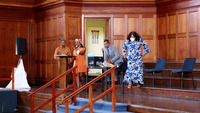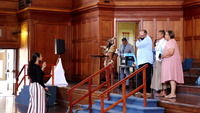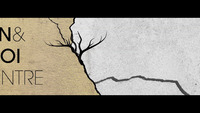The Khoekhoegowab Language
Namagowab ge Khoesangowa Naman tsî Daman xa Namibiab Botswanab tsî Suid-Afrikab !nâ ra !hoa e ba. Nē gowab ge ǁkhati Khoekhoegowab di ǂansa. ǁNāban ge 270 000 khoena Namagowaba ǁîn mamasgowab asa ū-hâ. ǀNî ǀon Namagowab din ge Namagowab, Nama-Damara, Namakwa, Bergdamara tsî Tama.
Khoekhoegowab ge Weskaap !nâ !urikhoen hās tsî ǀoroǀoros kurigas ai !nâ gere !hoa e. ǂGuro kurika, ǁaube 200 kurigu !gasib dis !nâ, hoaraga khūb ū ǀnana es tsî uîǀgaub !nâ. ǂGui Afrikaans !hoa oan san tsî khoekhoen nēǁaeb dīn ge ǁnā ǁhu !gaeb dī. ǂGurokam Afrikaans ga ǀnais ge xoa mâ e hâ i nēs ge 1590 ǁhai !gâb ai ge tsoatsoa. kaira khoekhoen ge ǂgau !gâib !nâ Namagowaba gera !hoa 1940b kose 1948 ǂGaeǂguiǂgas Afrikaans ǁgariǂgas Apartheid ǁkhāǁkhās gowab dīs !aromâs ge (Naman tsî San) gowaba ge bē[4].
English translation
Nama is a Khoesan language spoken by the Namas and Damaras in Namibia, Botswana and South Africa. It is also known as Khoekhoegowab. There are over 270,000 people with Nama as their mother tongue. Other designations for Nama include Namataal, Nama-Damara, Namakwa, Bergdamara and Tama.
Khoe was spoken in the present Western Cape in precolonial and diminished during colonial times, at the early Cape colony during almost 200 years of enslavement, complete land dispossession and cultural imperialism. Many of the Afrikaans-speaking ‘Coloured’ communities today in the region are descendants of the Cape Khoe and San. Although an early form of Afrikaans is already recorded as having emerged in 1590 at the Cape, many Khoe-descendant elders spoke the language in secret at least until the 1940s. After 1948, with the introduction of enforced Afrikaans as policy of Apartheid Education, the language vanished from these communities due to fear. Afrikaans contains Khoe and San words[4].
[4] Bam, J, 2021. Ausi told me: Why Cape Herstoriographies Matter. Jacana: Cape Town.
The Spoken Language
Literature related to Khoekhoegowab
-

Ausi told me: Why Cape Herstoriographies Matter
Ausi Told Me: Why Cape Herstoriographies Matter provides fascinating insights into life at the Cape over several centuries, the indigenous inhabitants and their accumulated knowledge, and how attempts were made to systematically erase this knowledge during the colonial and apartheid eras. Yet the wisdom of the ages still resides with the Ausidi, the female, intergenerational knowledge-keepers who are revered for the central role they played in Rondevlei, Hardevlei and other communities on the Cape Flats before the forced removals from the 1960s onwards changed the landscape forever. The book delves into many of the untold stories of the Cape, challenging various scholarly assumptions about the origins and enduring influence of the Khoi and San in the languages and cultures of southern Africa. The meticulously well-researched text is also skilfully interwoven with stories from current and former residents of the Cape Flats who speak candidly about their childhood experiences, the vast expanses of plants and flowers that used to more than satisfy local communities’ food and medicinal requirements, and the Ausidi – the formidable yet selfless family matriarchs, many of whom refused to be cowed by the apartheid regime’s forced removal policy and fought to protect their cherished livestock and land. Ausi Told Me: Why Cape Herstoriographies Matter serves as a reminder that popular history is not unassailable; it should be regularly questioned and, where necessary, challenged. The book makes a powerful case for a decolonised approach to exploring and interpreting southern Africa’s neglected past – in which the stories, dreams, visions and rituals passed down through the generations are recognised once more as critical sources of scholarly knowledge and physical and emotional wellbeing. -

Toponymica Hottentotica: B (A-Z)
This volume contains the information derived from the second of phase of the authors research project on Khoikhoi topographical names. It provides further insights into the motivations behind Khoikhoi place naming conventions. -
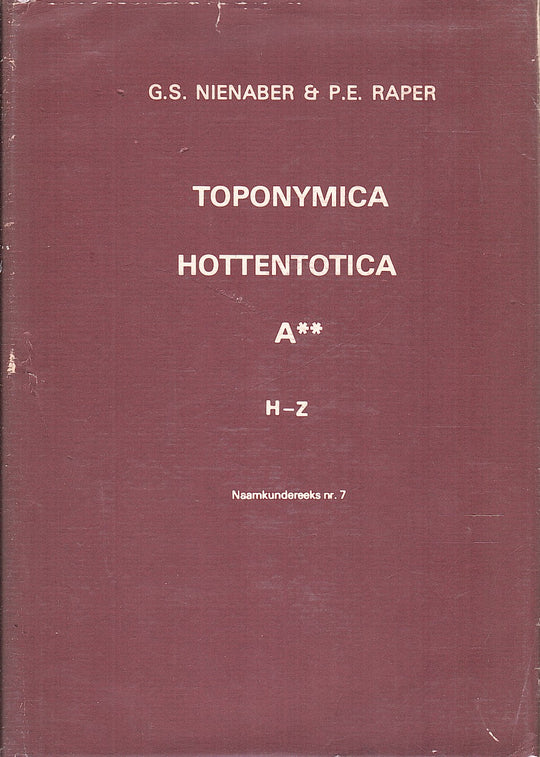
Toponymica Hottentotica: A2 (H-Z)
This volume provides readers with a list of place and farm names through the lens of the Khoi people. Included with each entry is descriptive information as documentary evidence of that the Khoi place names existed. This specific volume contains the entries from H-Z. -

Toponymica Hottentotica: A1 (A-G)
This volume provides readers with a list of place and farm names through the lens of the Khoi people. Included with each entry is descriptive information as documentary evidence of that the Khoi place names existed. This specific volume contains the entries from A-G. -

My tribe is the Hessequa. I’m Khoisan. I’m African’: Language, desire and performance among Cape Town’s Khoisan language activists
In this article we provide a discussion of present-day Khoisan activism in Cape Town, South Africa. The main actors in this movement are people whose heritage is complex: their history can be traced back to the early days of the colonial settlement, reflecting the interactions and cohabitation of the indigenous Khoisan, slaves and the European settlers. Currently, their main languages are English and Afrikaans; yet, efforts are also made by activists to learn Khoekhoegwab. In discussing the Khoisan resurgence we draw on a wide range of sources. The data include: in-depth interviews with language activists; video and audio recordings of ceremonies and other cultural events; discussions and performance of language and identity on blogs and tweets; newspapers; linguistic landscapes; and, finally, artistic performances (with particular focus on the hiphop opera Afrikaaps). We argue that Khoisan activism expresses a deep-seated desire for an identity – linguistic, political and cultural – that is both historically rooted and meaningfully created in the present. Khoisan activism is not only a political program but also an aesthetic-artistic as well as heteroglossic performance, and as such allows for new ways of conceptualizing language revitalization. -

A forgotten first people: The Southern Cape Hessequa
The present book continues the series on South Africa's 'invisible' earliest people with the Hessequa, who pastured their cattle along the south-east Cape coast -- all the way from the present town of Swellendam to Albertinia, and even beyond -- long before the European colonists arrived. They may be better described as a "Khoekhoe community", rather than what the early history books pejoratively called "Hottentots". In the current dynamic debate in South Africa about the rights of cultural and linguistic minorities, however, the voices of their descendants are not being heard, nor are they appropriately acknowledged by the powers that be. By writing about them and taking up their cause, Mike de Jongh opens a window on their history, their current lives, and their rightful place in the present-day Republic of South Africa. -

New perspectives on the study of Khoisan
-

Contemporary studies on Khoisan : in honour of Oswin Köhler on the occasion of his 75th birthday
Two volumes -

Hottentots
-

The phonetics of the Hottentot language
-

The musical practices of the /?Auni and #Khomani Bushmen
Unvailable - can be determined when item is in hand -
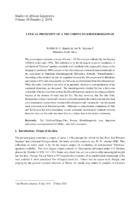
† Lexical proximity of a Xri corpus to Khoekhoegowab
Th paper examines a corpus of some 1 130 Xri concepts collected by Jan Snyman (UNISA) in the early 1970s. This collection is by far the largest corpus of vocabulary of self-declared "Griekwa" speakers available, and is unlikely to be surpassed infuture, as the language is moribund. 1096 concepts of this Xri corpus are compared dialectometrically to the equivalents in Namibian Khoekhoegowab (Khoekhoe, formerly “Nama/Damara”).


